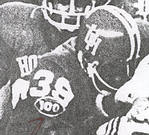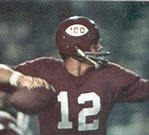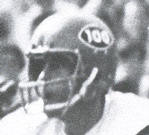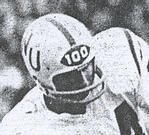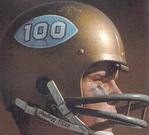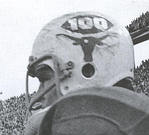Dear Dr. Del Rye,
First I would like to say that I've been logging on to helmet hut for
at least 2+ years. I like how the site continues to grow on an almost
daily basis. I usually log on to the site at least once a day. It's a
wonderful site. Keep up the good work. I hope you all have continued
success. Now down to business. I can recall in the early 80's the Kansas
City Chiefs entire football team (every position) wearing the Dungard
Facemask. They were the only team that I could recall doing this. Was
there a reason behind it? How long did the Chiefs use the Dungard as team?
Sincerely,
James
Dear James:
Thanks for the nice words. You will hopefully enjoy a new regular
column called "Talking Helmets with the Equipment Manager" starting this
month. The first installment is an interview with the original Chief's
equipment manager Bobby Yarborough and he actually speaks about Dungard
face masks. In the late 1960s Bobby met the owner of Dungard, Dr. Dunning,
at a trade show. Dr. Dunning sent Bobby every style of Dungard face mask
to test. Bobby found them to be stronger, lighter and offered more facial
area protection compared to other face masks. Bobby always gave the Chief
players their choice of what type of face mask to wear but by the 1980s
most of players were in agreement with Bobby's preference for the Dungard
face masks. After 23 years of loyal service Bobby was fired in 1983 by new
coach John Mackovic. John Phillips was hired to replace Bobby and he
immediately scrapped all the team's Dungards and switched to Schutt. John
had noticed that the Chiefs had suffered an unusually large proportion of
neck strains compared to other teams. He attributed this phenomenon to the
teams preference for the Dungards because they were directly bolted
(without attachment clips) at the upper front of the helmet. This limited
the face mask's ability to absorb shock transferring it instead to the
players neck. In comparison the Schutt face masks used which used energy
absorbing flexible clips at both the top and side attachment positions. To
John's credit the Chief's neck strain type injuries were subsequently
reduced after switching to the Schutt face masks.
Dear Dr. Del Rye:
I have noticed in pictures of players wearing Riddell suspension
helmets that the leather jaw pads seem to greatly range in thickness. Was
this the result of excessive wear or shrinkage when the leather got wet or
did they come in all different sizes?
Eric
Dear Eric:
Thanks for the technical question. Riddell produced four different size
jaw pads, small, medium, large and extra large. It was critical to
properly fit a player with correct size jaw pads to minimize the side to
side movement of the helmet also know as wobbling. A player with a thinner
face would usually require large or extra large size jaw pads while a
player wider face would most likely use small or medium size
jaw pads. Unfortunately in the old suspension helmet era many players wore
incorrectly fitting jaw pads because they would often just pick out a
helmet that felt comfortable and bypass the equipment manger's efforts to
properly fit the helmet. The proper fitting of jaw pads has been
discovered to be so crucial that modern era vinyl jaw pads are now offered
in several more sizes and stocked by actual thickness by inches.
Dear Dr. Del:
Can you describe how the stripes were applied to the 1964 and 1965
Houston Oilers helmets?
Thanks, John (AFL guy)
Dear John:
This is a very interesting question because it shows how creative the
Riddell factory was in their glorious suspension helmet making days. The
process started with a molded white shell (Riddell did not impregnate
shells with color until the later 1960s). A three inch wide section was
taped off down the center ridge of the helmet. The entire shell was then
painted with "Oiler" blue. The tape was removed to reveal an
unpainted four inch wide center ridge reflecting the original molded white
color. Finally 3/4 inch wide red stripes were painted on each side of the
slightly raised one inch wide center ridge. Based on viewing archival film
of their manufacturing processes we believe Riddell used a preset template
to paint these side stripes, otherwise, the helmet was taped off again as
needed to complete this process. The resulting striping pattern reflected
the colorful alternating white / red / white / red / white design.
Dr. Del Rye,
As a longtime football fan I have certain teams and themes that are my
favorites. One of them is the 1969 college football season in which
some teams wore special decals on their helmets commemorating the centennial
year of college football. I want to know why only some teams wore these
decals. Why did some only wear the decals for certain games; for example
national champion Texas only wore them four times; the opener at Cal, the
Arkansas game, the Oklahoma game, and in the Cotton Bowl against Notre
Dame. My guess is these games were nationally televised. Why did some only
use one decal; for example Southern Cal's lone decal was on the left side,
Nebraska's was directly in the front. Each team's decal was color
coordinated to match their colors, and was basically of the same design, yet
Purdue's was totally different than all the others. I'd like to see you
replicate a college football helmet from this year with the "100" decal on
it. My recommendation is Southern Cal or UCLA. Or Bama or Ole Miss. Or
Harvard or Princeton. Or Michigan State or Purdue. Keep up the good work.
Mike Marchesani
Dear Mike:
You have made some great observations regarding the 100 year
anniversary of college football sticker. It appears that almost every team
had their own version of this ceremonial sticker. Some teams such as the
University of Michigan did not wear a sticker while others wore patches on
their jerseys rather than helmet stickers. This event is probably one of
the best examples of what happens when each schools is allowed
to individually decide how to commemorate a country wide promotion or
celebration. Needless to say, compared to the alternative -- a
somewhat boring generic approach, we just love the character ridden
interesting variations used to celebrate the 1969 "100" year anniversary
of college football! Please enjoy the following pictures of helmets from
that year:
Houston
Alabama
Princeton
Nebraska
UCLA
Texas
